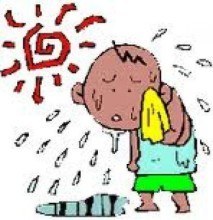Temperature and Relative Humidity


Everyone has heard of the necessities of life, air, food, water, sleep and so on. Well, somewhere after aforementioned and before friendships, relationships, and vacation, comes COMFORT. Without comfort, the rest of it all be damned!
We visit hundreds of homes and businesses each year for mold inspection or other indoor air quality issues. There are certain parameters that we look for in each one – the first and foremost in all is the indoor temperature and relative humidity. These are key to comfort.
Temperature and relative humidity are so important to our well-being, yet most people overlook its importance. ASHRAE (American Society of Heating Refrigeration Air-conditioning Engineers) recommends that occupied spaces be maintained with temperatures between 72 and 75° F and relative humidity under 60% to minimize the growth of allergenic and pathogenic organisms. Science tells us that the effect of bacteria and viruses significantly increases as RH goes below 35% and above 65%. Molds and mites both increase as RH goes above 60%. Most molds (fungi) require a surface moisture activity of at least 0.61 – or 61% relative humidity at the surface mold will grow on.
 On the other hand, allergic rhinitis, asthma and respiratory infections increase below 40% RH. Most healthy humans cannot exist in an environment below 30% RH for a long period of time. Fish tanks and toilets will go dry. Most airliners operate at 5 – 10% RH when pressurized at flying altitudes. Most people don’t notice a big issue in flights less than three hours, but longer transoceanic flights cause most to suffer from dry eyes, throat irritation and other minor health issues.
On the other hand, allergic rhinitis, asthma and respiratory infections increase below 40% RH. Most healthy humans cannot exist in an environment below 30% RH for a long period of time. Fish tanks and toilets will go dry. Most airliners operate at 5 – 10% RH when pressurized at flying altitudes. Most people don’t notice a big issue in flights less than three hours, but longer transoceanic flights cause most to suffer from dry eyes, throat irritation and other minor health issues.
The first modern electrical air conditioning unit was invented in 1902 by Willis Carrier. The man whose name became synonymous with indoor air comfort was looking for a solution to a printing and publishing company’s humidity problem. Today his name carries on as an icon of the air conditioning and comfort industry, but the first purpose of what he was attempting to cure was a high humidity problem. Think of this way: do you feel more comfortable when the temperature is 85° F and a relative humidity of 60% or when the temperature is 85° F and the relative humidity is 90%? Simple question that we all know the answer – lower humidity means better comfort.
Since we all know the solution to our ultimate comfort, why aren’t we more concerned about it? Relative humidity may be a mystery to many people, so most don’t bother. In fact, it is a complicated issue, dew point, temperature, wet bulb temp, dry bulb temp, OMG!
There is a simple solution. Monitor your relative humidity. Nothing difficult there; this isn’t rocket science. Remember ASHRAE (the industry engineers) says 30% to 65% is OK. Florida rarely has the problem of too low humidity – it’s the upper end of the range we are concerned with. Newer homes that are built tight and have good A/C systems should have no problem staying well below 50% during the summer heat. Older homes may not be able to accomplish that. Most wall thermostats for the A/C system only have temperature settings and those are not very accurate. The answer is a  desktop Thermo-Hygrometer. They are available in many locations and many price ranges. The two important things the meter needs to show: first, temperature and second, relative humidity. Many available today have readings for outside or, clocks, barometric pressure and all kinds of other statistics. A single zone desktop digital thermo hygrometer will set you back $25 – 50. Any less and you are not usually getting much; $50 gets you a good one. Stores like Walmart and Sears usually have some in store. Online gets you a variety of models from Oregon Scientific, LaCrosse, Extech and more. No brand recommendations or endorsements here, but we have experience with those and most are fairly accurate.
desktop Thermo-Hygrometer. They are available in many locations and many price ranges. The two important things the meter needs to show: first, temperature and second, relative humidity. Many available today have readings for outside or, clocks, barometric pressure and all kinds of other statistics. A single zone desktop digital thermo hygrometer will set you back $25 – 50. Any less and you are not usually getting much; $50 gets you a good one. Stores like Walmart and Sears usually have some in store. Online gets you a variety of models from Oregon Scientific, LaCrosse, Extech and more. No brand recommendations or endorsements here, but we have experience with those and most are fairly accurate.
Ok, so you shelled out the cash for the meter; now what? First, set it somewhere near the main return air grille for you A/C (usually where the largest filter hangs out). Keep an eye on it and see what kind of readings you get. You can record readings at different times of the day. Leave it for a week or so before moving to another location. Problems in another area of the home or office, move it there. Adjust your A/C thermostat to suit you. Remember that the important thing here is to maintain relative humidity as low as possible below 50% for comfort and reducing the possibility of mold growth. The longer the A/C system runs, the lower the temp and relative humidity. Sometimes being energy conscious will pay you back with mold growth.
